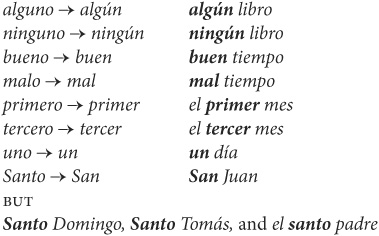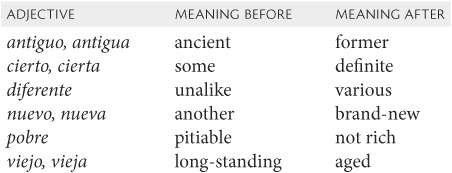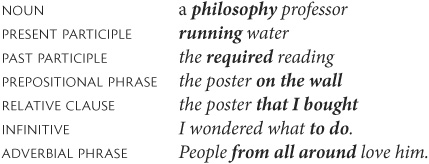 Introducing adjectives
Introducing adjectives
 Introducing adjectives
Introducing adjectivesDefinition
See page 7.
Forms
Some English adjectives are invariable, while others change form. These changes depend on adjective type. The types are discussed separately below.
Uses
Adjectives are primarily used as
1. modifiers of nouns or pronouns.
2. complements of either the subject or an object.
An adjective’s function determines its position in a sentence.
1. As a modifier, an adjective usually comes before the noun or pronoun that it modifies.

2. As a modifier of an indefinite pronoun, an adjective follows the pronoun.

3. As a subject complement, an adjective follows the verb to be or the linking verb and describes the subject.

4. As an object complement, an adjective follows the direct object noun or pronoun.

Types
Each of the following adjective types is discussed separately below.
1. Descriptive (page 46)
2. Proper (a kind of descriptive adjective) (page 50)
3. Limiting (includes demonstratives, possessives, indefinites, interrogatives, numbers, and determiners) (page 50)
 Introducing adjectives
Introducing adjectivesForms
An adjective in Spanish agrees in gender and number with the noun it modifies. If an adjective describes a mixed group of nouns (masculine and feminine), the adjective is masculine plural.
Uses
As in English, Spanish adjectives are used as modifiers and complements, but their position in a sentence is different (see page 47).
 Descriptive adjectives
Descriptive adjectivesDefinition
Descriptive adjectives describe a noun or pronoun.
Forms
Many of these adjectives may be inflected to show comparison.
 Descriptive adjectives
Descriptive adjectivesForms
In Spanish, descriptive adjectives that are masculine singular typically end in -o, and feminine singular descriptive adjectives typically end in -a. Plurals are created by adding an -s. The masculine singular form is the one listed first in vocabularies and dictionaries.

1. Most descriptive adjectives whose singular forms do not end in -o or -a have a single form. The plural is formed by adding -es unless the descriptive adjective already ends in -e, in which case -s is added to form the plural.

Note that spelling changes are employed to maintain pronunciation.
2. Adjectives ending in -án, -ón, -ín, and -or add -a for the feminine. Masculine plurals add -es, and feminine plurals are formed by adding -s.

3. Comparative forms of adjectives ending in -or (superior, ulterior, etc.) have the same form in the masculine and feminine.

4. Adjectives indicating nationality that end in a consonant form the feminine and feminine plural regularly; the masculine plural ends in -es.

 Descriptive adjectives (continued)
Descriptive adjectives (continued)5. A small group of adjectives (not just descriptive adjectives) have a shortened form that is used before masculine singular nouns.

6. The adjective grande becomes gran before most singular nouns of either gender; its meaning then becomes “great” rather than “big.”
un gran amigo, una gran amiga
7. If two adjectives that have a short form are used before a singular noun, they both use the short form unless they are connected by a conjunction, such as y (“and”).
un mal tiempo, el primer buen día, el primero y buen disco
WORD ORDER Normally, a descriptive adjective in Spanish follows the noun it modifies. First, you say what you’re talking about (for example, una casa), then you describe it (for example, una casa blanca).
1. Some adjectives change meaning, depending on whether they appear before or after the noun.

2. There are a number of Spanish adjectives whose English equivalent has the same meaning, but whose placement in Spanish offers a variation in connotation. In these cases the position before the noun suggests an inherent quality.

3. When two descriptive adjectives are used together to modify a noun, the one most closely associated with the noun comes first.

4. It is important to place adjectives appropriately.

 Comparison of adjectives
Comparison of adjectivesDefinition
The three degrees of comparison are positive, comparative, and superlative.
Forms
English forms comparisons in the following ways.
1. Regular comparisons add -er and -est to short adjectives, sometimes with a minor change in spelling.

2. Longer adjectives are compared by using more and most, or the negatives less and least.

3. Some adjectives have irregular comparisons.

4. Adjectives that cannot be compared include absolutes, which are by definition superlative. Uniqueness and perfection cannot be brought to a higher degree.
unique
perfect
5. When a comparison is made, several words may introduce the second element: than, in, and of all.

If an adjective is already in the comparative, more is not added. Greater contrast may be expressed by words like much or more.
much smaller
much more difficult
 Comparison of adjectives
Comparison of adjectivesForms
Spanish forms comparisons in the following ways.
1. Most Spanish adjectives form the comparative with más (“more”), tan (“as,” in the sense of equal), or menos (“less”) plus the adjective.

2. Superlatives are formed with the definite article plus the comparative (for example, la más grande and el menos importante).
un auto rápido ~ un auto más rápido ~ el auto más rápido OR el más rápido
una camisa bonita ~ una camisa menos bonita ~ la camisa menos bonita
OR la menos bonita
 Comparison of adjectives (continued)
Comparison of adjectives (continued)The adjective remains in the same position, whether it is positive, comparative, or superlative.

1. The most common irregular comparisons are the following.

2. Adjectives that cannot be compared include absolutes, which are by definition superlative.

Since uniqueness and perfection cannot be brought to a higher degree, el/la/los/las más cannot be used with them.
3. To link elements in a comparison, use que with más (“more”) or menos (“less”), and use como with tan (“as,” in the sense of equal).
Jimena es más grande que María.
Marco es menos grande que Felipe.
Juan es tan grande como yo.
For a superlative, use de to compare one to a group.
Jimena es la más grande de su familia.
Felipe es el más grande de su clase.
 QUICK CHECK
QUICK CHECK
COMPARATIVE CONSTRUCTION WITH (1) los hombres, (2) las mujeres, AND (3) ser inteligente

SUPERLATIVE CONSTRUCTION WITH (1) Consuelo, (2) la clase, AND (3) ser lista

Note that nouns may be replaced by noun phrases or pronouns.
Make sure that the word order is correct, that there is subject-verb agreement, and that the adjective agrees with the noun or pronoun it modifies.
 Proper adjectives
Proper adjectivesDefinition
A proper adjective is a descriptive adjective formed from a proper noun (see page 12).

Forms
In English, both proper nouns and their adjectives are capitalized. Sometimes, their forms are indistinguishable.

 Limiting adjectives
Limiting adjectivesDefinition
A limiting adjective does not add to your knowledge of a noun; instead, it directs you toward the right one by limiting the choices. The following examples show the types of limiting adjectives.

Each of these types of limiting adjectives are discussed separately.
 Demonstrative adjectives
Demonstrative adjectivesDefinition
Demonstrative adjectives point out which of a group is/are the one(s) that you are referring to.
Forms
These adjectives have the same forms as the demonstrative pronouns (see page 38) and distinguish in the same way between near and far and between singular and plural.

There is no agreement in person, gender, or case. The demonstrative adjective precedes its noun.
This woman is talking to that man.
These little boys hate those dogs.
 Proper adjectives
Proper adjectivesForms
In Spanish, proper adjectives are formed from proper nouns, but they are not capitalized.

 Limiting adjectives
Limiting adjectivesSee the discussion on the opposite page.
 Demonstrative adjectives
Demonstrative adjectivesForms
A demonstrative adjective agrees with the noun it modifies in gender and number.

Uses
In Spanish, the near/far distinction is expressed by the forms este/ese/aquel. Este/esta (“this”) and estos/estas (“these”) express what is nearest to the speaker; ese/esa (“that”) and esos/esas (“those”) express what is farther from the speaker; and aquel/aquella (“that over there”) and aquellos/aquellas (“those over there”) express what is farthest from the speaker. Use forms of ese for “that” unless it is necessary to make a point of the distinction.

 Possessive adjectives
Possessive adjectivesDefinition
Possessive adjectives modify a noun by telling to whom or what it belongs.
Forms
These adjectives indicate the person, number, and gender (in the third-person singular) of the possessor.

The adjectives do not tell anything about the person or thing that is possessed.

Uses
The possessive adjective is always used with the noun.
my mother
our child
your turn
If the noun is omitted, a pronoun must be used (for example, mine, ours, or yours) (see page 28).
 Possessive adjectives
Possessive adjectivesDefinition
Spanish possessives are adjectives, so they agree in gender and number with the noun they modify, not with the possessor.
Forms
Spanish possessive adjectives have the following forms.

The adjectives mi/mis/tu/tus/su/sus indicate singular and plural, but they do not indicate gender.
The adjectives nuestro/nuestra/nuestros/nuestras/vuestro/vuestra/vuestros/vuestras indicate both gender and number.
The adjectives su/sus have several English equivalents (“his,” “her,” “its,” “your,” “their”). Therefore context may clarify which English possessive adjective is indicated. If context is not clear, use de + a noun or pronoun for clarification.

English “your” has several Spanish equivalents, depending on the subject of the Spanish sentence. It is expressed by su/sus if the subject of the Spanish verb is usted or ustedes; by tu/tus if the subject is tú; and by vuestro/vuestra/vuestros/vuestras if the subject of the verb is vosotros or vosotras.
In Spanish, to stress the possessive adjective, use the long form of the Spanish possessive adjective.

This form of the possessive adjective is placed after the noun.

 Interrogative adjectives
Interrogative adjectivesDefinition
Interrogative adjectives ask a question about limitation.
Forms
These adjectives have case in English.
1. Subject and object cases: which? what?
2. Possessive case: whose?
These forms are invariable.
Uses
Interrogative adjectives are used
1. to ask a question.

2. in an exclamation.
What a pretty house!
What a job!
 Indefinite adjectives
Indefinite adjectivesDefinition
Indefinite adjectives refer to nouns or pronouns that are not defined more specifically.
Some students learn fast.
Any girl will tell you.
Both lectures are at 10 o’clock.
Each/Every class has its value.
I want another pen.
Such behavior is terrible.
Forms
These adjectives are invariable, that is, they do not change their form. Some, however, may be used only with singular nouns (for example, each, every, another), some only with plural nouns (for example, both, other), and some with either singular or plural nouns (for example, some: some coffee, some people).
 Interrogative adjectives
Interrogative adjectivesForms
In Spanish, the interrogative adjective is inflected for gender and number. It agrees with the noun it modifies.

The interrogative adjective ¿qué? has only one form and therefore does not indicate gender or number.
The interrogative adjective ¿cuál? indicates number but not gender.
¿Cuánto?/¿cuánta? (“how much?”) and ¿cuántos?/¿cuántas? (“how many?”) indicate both gender and number.
Uses
Interrogative adjectives are used
1. to ask a question.
¿Cuántos libros tienes?
¿Qué hora es?
¿Qué trabajo tenemos para mañana?
¿Cuál es el trabajo para mañana?
2. in an exclamation.
¡Qué casa más bonita!
¡Qué lío!
 Indefinite adjectives
Indefinite adjectivesDefinition
Spanish indefinite adjectives are similar to those in English.
Algunos estudiantes aprenden rápidamente.
Cualquier mujer se lo dirá a usted.
Ambas conferencias se reúnen a las diez.
Cada clase tiene valor.
Quisiera otro bolígrafo.
Tal comportamiento es reprensible.
Forms
An indefinite adjective agrees with its noun in gender and number, just as descriptive adjectives do.
 Other limiting adjectives
Other limiting adjectivesOrdinal numbers
These numbers indicate the order in which things come. One, two, and three (and all numbers ending in one, two, and three, except eleven, twelve, and thirteen) have irregular ordinals.
first, second, third
All other ordinal numbers are formed by adding -th.
fourth, ninth, sixteenth
Determiners
Determiners are often classified as adjectives (see page 16).
 Other adjectival forms
Other adjectival formsMany other kinds of words—even though they are not adjectives themselves—may be used as adjectives (that is, to describe a noun or pronoun).

 Other limiting adjectives
Other limiting adjectivesOrdinal numbers
In Spanish, ordinal numbers are essentially vocabulary items and must be learned as such. They agree in gender and number with the noun they modify.
primer presidente
primera actriz
quinto tomo
décima lección
Determiners
See pages 17–18.
 Other adjectival forms
Other adjectival forms